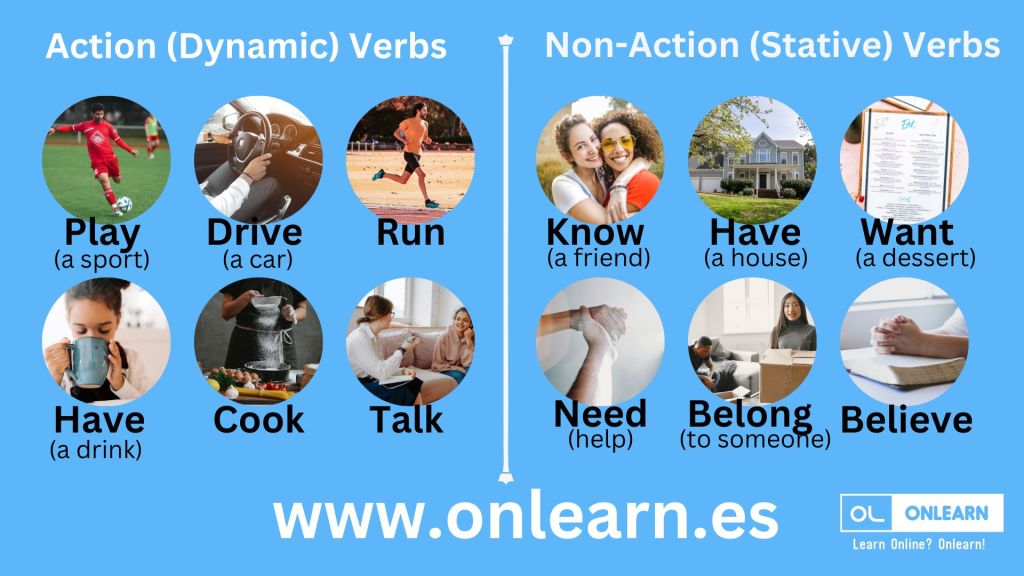Present Simple & Present Continuous.
This lesson will help you to learn how and when to use the present simple and when to use the present continuous. Sometimes one is required, at other times we need to use the other. You can check your understanding of this topic with the present simple Vs. present perfect grammar exercises or consolidate your comprehension of these forms in context with the present simple Vs. present perfect conversation questions. There is a classroom presentation tool for this topic in the “materials” tab at the top of the page. This topic is part of a B1 level English-grammar course.


The Present Simple
When to Use the Present Simple Tense.
We use the present simple to talk about:
Facts.
Habitual / Regular actions.
States.
The present simple is used for facts or things which are always true, states and for habitual or routine actions. Do not use the present simple for actions in progress.
Using the Present Simple for Facts.
Factual information that refers to the present uses the present simple;
“Christmas is in December.”
“I am English.”
We use the present simple for facts that are related to the present, for things that are always true and for events that are already scheduled or timetabled. In the examples above “I am English” is a fact that refers to the present and something that is always true. “Christmas is in December” is always true and is something that is timetabled.
Using the Present Simple for Regular or Habitual Actions.
We often use the present simple to describe habitual or regular actions;
“I go swimming once a week.”
“I usually have a beer in the evening.”
“I work from Monday to Friday.”
Present Simple with Adverbs / Expressions of Frequency.
We use the present simple to talk about things that we do regularly or habitually. It is common to combine these regular activities with adverbs of frequency or expressions of frequency to describe how often we do them.
Adverbs of frequency like;
Always
Usually
Sometimes
Hardly ever
Never
Or Expressions of frequency like;
Once a week
Every month
Every week
From time to time
Twice a year
Are often used with the present simple because they talk about how habitual something is.
Adverbs of frequency go before the main verb. Exceptions to this rule are the verb “to be” and modal verbs. Adverbs of frequency go after “to be” or modal verbs. Expressions of frequency usually go at the end of the sentence, clause or phrase. For example:
“I can never understand him, he always speaks quietly.”
“We usually go shopping once a week.”
Using the Present Simple for States.
We use the present simple to talk about states, for example;
“I am tired.“
“He wants a drink.“
“I don’t believe him.“
“He needs some help.“
“It is hot.”
States are not actions, but things that don’t change dynamically. This could be your hair colour (“He has red hair.”) or nationality (“I am English”).
“To Be” in the Present Simple
Positive
“He is English.”
Negative
“He isn’t English.” / “He is not English.”
Question
“Is he English?”
“Normal Verbs” in the Present Simple
Most verbs, that is to say, not modal verbs or the verb “to be“, need auxiliaries and 3rd person conjugation in the present simple.
Examples of “normal verbs” in the present simple tense.
Positive
“They speak English.”
Negative
“They don’t speak English.”
Question
“Do they speak English?”
Present Simple 3rd Person Conjugation.
Be careful with the 3rd person conjugation (he, she, it) it has a different conjugation which usually ends with -s or -es, even the auxiliary verb “do” becomes “does”.
“He speaks English.”
“He doesn’t speak English.”
“Does he speak English?”
When we use the auxiliary verb “does” we leave the main verb in the bare infinitive form.
The Present Continuous
When to Use the Present Continuous
The present continuous is used for:
Actions in progress now
Actions in progress around this time
Future plans.
Let’s just have a quick look at how to form the present continuous.
How to Form the Present Continuous.
We form the present continuous with the verb to be and a verb in the-ing fom.
“To Be” + ________ ing.
“He is swimming“
“We aren’t waiting.”
“They are singing.”
Now, let’s have a look at some examples of the present continuous.
Present Continuous Examples
Positive
“They are speaking English.”
Negative
“They aren’t (are not) speaking English.”
Question
“Are they speaking English?”

Non-Action Verbs

Beware of non-action verbs!
Some verbs refer to STATES and not ACTIONS. These verbs are called “non-action” or “stative” verbs.
In English, just like in many other languages, we tend to avoid these verbs in continuous forms.
The verb “have” (for possessions) is a state, not an action, so it is incorrect to say;
“I am having a house with a garden.”
It is necessary to use the present simple;
“I have a house with a garden.”
Some other verbs which refer to states are;
- Want
- Need
- Believe
- Have
- Belong
- Know
- Like
- Love
- Hate
- Hear
- Matter
- Mean
- Prefer
- Realize
- Remember
- Seem
Although we avoid stative / non-action verbs in the present continuous, some verbs can have stative and action meanings! Verbs like “have” can be used with a stative meaning
“I have a big house.”
or as an action
“I am having a drink with some friends.”
Present Simple and Present Continuous Exercises.
Use these interactive tests to check that you understand the grammar in this topic!
This presentation tool can be used by teachers or students to learn, teach or revise the use of the present simple and present continuous tenses in English grammar (Level B1). Use the arrows at the bottom of the presentation or the arrow keys on your keyboard to cycle through the slides. You can access each slide easily with the navigator at the bottom of the presentation which also has fullscreen and pointer options. If you want to test yourself on this topic, try the interactive tests here.
